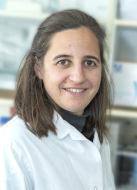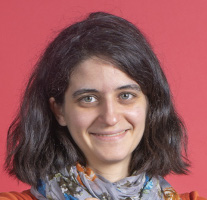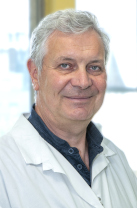
The 8th International Congress of Myology will be held in Paris from 22 to 25 April 2024.
Here are the eight themes that experts from the Institute of Myology will be presenting to the international community over the next few days:
 Tuesday 23 April – Muscle Fibrosis / Ageing Session
Tuesday 23 April – Muscle Fibrosis / Ageing Session
11h30 : Capucine Trollet – Cellular actors and ECM components of human fibrosis in myopathies
Fibrosis is defined as the excessive accumulation of extracellular matrix (ECM) components as a result of a failed tissue-repair process. In muscle, fibrosis is a common complication in many clinically and pathologically different muscle diseases including Duchenne muscular dystrophy (DMD), oculopharyngeal muscular dystrophy (OPMD), inclusion body myositis (IBM) or fascio-scapulohumeral muscular dystrophy (FSHD). Excessive accumulation of ECM alters the muscular function and the potential of innovative therapeutic strategies. Several cellular actors are known to be involved in the establishment and the maintenance of the fibrosis: fibroadipogenic progenitors (FAPS), macrophages, as well as satellite cells. The ECM, apart from its essential role as an architectural scaffold, has also a pivotal role in this process influencing muscle-resident cells through biochemical and biomechanical signals. Today there is no efficient treatment to cure muscle fibrosis, that represents a serious hurdle for the different therapeutic approaches which are now arriving in the clinic.
Using mass spectrometry, we characterized the ECM composition of DMD, OPMD and IBM human skeletal muscle biopsies. We identified a few shared ECM protein components as well as many specific ones for each pathology, highlighting differences in the amount and nature of ECM components. We investigated the role and nature of FAPs from human fibrotic muscles and compared them to FAPs from healthy muscle. Combining in vitro ECM production and secretome analysis, we identified FAPs as the main producers of this deposition in pathological muscle and highlighted their deleterious effect on muscle differenciation.
Altogether, this work on human muscle biopsies provides a better understanding of the ECM proteome of the muscle in pathological conditions and the key role of FAPs and their secretion.

Tuesday 23 April – Congenital myopathies Session
11h30 : Ana Ferreiro – ASC-1 related myopathy reveals transcriptional co-activation as a new regulator of myogenesis: expanding the molecular spectrum and identifying the mechanisms of an emerging congenital myopathy
While myogenesis is a key process for muscle structure, function and regeneration, the mechanisms that regulate this process of myogenesis and how their defects may cause muscle diseases and/or represent therapeutic targets are not fully understood. On the other hand, the study of transcriptional co-regulators is an emerging field in genetics, which has attracted increasing attention in recent years.
With the recent identification of a form of autosomal recessive congenital myopathy due to mutations in the TRIP4 gene, encoding the ASC-1 subunit of the ‘Activating Signal Co-integrator-1’ protein complex, we have established that defects in transcriptional co-regulation represent a new pathway associated with inherited neuromuscular diseases.
We report here the phenotypic and molecular characterisation of four ASC1-RM patients from two Roma families from France and Spain. All patients have the same homozygous mutation in TRIP4, suggesting a founder effect in this population. In addition, using a knockdown of Trip4 (Trip4-KD) in murine myogenic cells and patient muscle samples, coupled with transcriptomic studies, we demonstrate a role for ASC-1 as a key regulator of early myogenesis.
These results reveal the ubiquitous transcriptional co-activator ASC-1 as a new key regulator of a specific cellular process such as muscle differentiation, through a targeted interaction with transcription factors that are critical regulators of myogenesis.
 Tuesday 23 April – Young investigator Symposium
Tuesday 23 April – Young investigator Symposium
14h30 : Fiorella Grandi – RNA-sequencing of Type II SMA paravertebral muscle after treatment reveals distinct molecular subtypes
Spinal Muscular Atrophy (SMA) is rare developmental disorder predominatly affecting children, which results in muscle weakness, paralysis, and eventual death if left untreated. Traditionally, the disease was considered to originate with motor neurons, the cells that innervate the muscle allowing for moment. However, recent advancements have shown that SMA is a whole body disease, with significant involvement of the muscle. SMA is caused by the loss of the gene SMN1, which makes a protein with a variety of roles inside the cell. Three treatments are available for SMA, which focus on increase the levels of the SMN protein. Two of these treatments, Nusinersen and Risdiplam, are given to Type II SMA patients, which generally have a later onset of SMA. However, to date no characterization has been performed on SMA Type II muscles after treatment. With this goal in mind, we collected paravertebral muscle from SMA Type II patients (n=8) after their treatment with Nusinersen and age matched controls (n=7) from the Myobank-AFM (Pitié-Salpêtrière Hospital). We were able to observe that despite the treatment successfully restoring the levels of SMN to the same degree as the control samples, we could observe changes in the muscle histology and other molecular characterstics. In particular, by using RNA-sequencing, we could classify the patients into three different groups, based on their molecular features.
Doing this, we observed that in one of these groups, there was a decrease in the molecules of the electron transport chain in the mitochondria. We were able to further validate that mitochondrial DNA (mtDNA) was widely downregulated in the samples, even after treatment. However, these changes in mitochondrial number were not observed in myoblasts derived from SMA patients, suggesting that the mitochondrial deficiency is not a direct consequence of the disease, but rather a downsteam consequence of the muscle’s development in an SMN-low enviornment at birth.
This work presents, to our knowledge, the largest analysis of RNA-sequencing of Type II SMA muscles samples after treatment and provides a molecular roadmap of the state of SMA muscle after treatment. Current efforts are focused on determining the molecular reasons – be they genetic, epigenetic, or clinical- for the heterogenous response to Nusinersen injection, and to test drug candidates to improve mitochondrial function and decrease DNA damage in skeletal muscle.
 Wednesday 24 April – CMT & Neuropathies Session
Wednesday 24 April – CMT & Neuropathies Session
10h30 : Tanya Stojkovic – Charcot-Marie-Tooth disease: an overview of genetic and phenotypic variability
Charcot-Marie-Tooth disease (CMT) and related neuropathies include many conditions in which neuropathy is the sole or predominant manifestation, as opposed to multisystem diseases such as mitochondrial or metabolic diseases, spastic paraparesis and spinocerebellar ataxias. CMT diseases represent the most frequent form of hereditary neuropathies (almost 75% of hereditary neuropathies), while hereditary sensory and dysautonomic neuropathies and distal motor neuropathies account for just 3% each. Almost 130 genes have been identified in these latter disorders. These genes are involved in myelin formation and maintenance, mitochondrial dynamics, cytoskeleton organization, axonal transport, and vesicular trafficking. A same gene is known to cause different phenotypes both from a clinical or electrophysiological point of view. The same gene can account for a demyelinating form (CMT1), an axonal form (CMT2) or an intermediate form (CMTI) of CMT. Indeed, considerable overlap exists, both phenotypically and genetically, among CMT and others hereditary diseases, such as spastic paraplegia, spinocerebellar ataxia, motor neuron disease or hereditary myopathies.

Wednesday 24 April – Outcome Measures / Physiotherapies Session
16h00 : Jean-Yves Hogrel – Natural history studies: challenges and limitations
At a time of unprecedented growth in therapeutic trials, we should keep in mind that the aims of patients are not the same as the aims of physicians, researchers, regulatory agencies or pharmaceutical companies. Schematically, and simplistically, while patients hope for a cure, physicians strives for better standards of care, researchers work to increase scientific knowledge, regulatory agencies seek to be convinced of the good use of public money and pharmaceutical companies want their products to be introduced onto the market. However, regardless of the ultimate goal, the need for objective outcome measures to assess the effects of therapeutic agents is fundamental. This is one of the aims of natural history studies (NHS) to provide insights into how a disease progresses over time. This understanding is fundamental for clinicians, researchers, and patients to anticipate the course of the disease, identify key milestones, and recognise potential complications. This is also crucial when the aim is to test the effects of a treatment in order to decide if it should go to the market. Sensitive outcome measures are essential especially if the effects of the treatment are modest or clinical trials are too short given the slow course of the disease. Furthermore, unsuccessful clinical trials may have been considered as failures because the efficacy criteria were not optimally chosen or measured.
NHS results and interpretations may be biased due to several reasons:
- subject heterogeneity
- possible erratic disease evolution due to specific events (arthrodesis, loss of ambulation…)
- ceiling and floor effects of the measurement tools (also generating zero and infinite)
- non-linearity of motor scales
- the definition of clinical meaningfulness
- measurement errors
- data expression methods (data normalised or not)
- statistical methods and covariates used for data analyses
- effect of growth and maturation in children and adolescents
- influence of the mutation on the phenotype
- …
Most of these factors will be discussed and exemplified using data acquired in several NHS in various neuromuscular disorders. The sources of bias in NHS should be scrutinised, particularly when historical cohorts are used as external controls in therapeutic trials.
 Wednesday 24 April – Outcome Measures / Physiotherapies Session
Wednesday 24 April – Outcome Measures / Physiotherapies Session
17h15 : Harmen Reyngoudt – Longitudinal quantitative MRI of forearm and arm muscles in dysferlinopathy
Dysferlinopathy is a hereditary dystrophic myopathy caused by mutations in the dysferlin gene and is characterized by a variable disease progression rate. The upper limb muscles are affected in the later stages of the disease, and muscle fat replacement of arm and forearm muscles follows thigh and leg involvement. Following the COS1 study funded by the JAIN foundation, a follow-up COS2 study was set up in 4 centers including 54 patients. MRI exams were performed at baseline, 6 months and 12 months, emphasizing arm and forearm but including also thigh and leg in ambulant patients. The upper arm muscles were more involved than forearm muscles and fat fraction increased more rapidly in the arm muscles. An inter-patient heterogeneity of disease progression was observed. Fat fraction increase over the course of one year was heterogeneous and was in line with lower limb disease progression. The persistent active muscle damage (inflammation) in some muscles (reflected by elevated water T2 values) was observed across the entire study.

Thursday 25 April – Inflammatory Myopathies Session
10h30 : Olivier Benveniste – Myositis classification for targeted treatments
Inflammatory myopathies can be classified into 4 entities: inclusions body myositis (IBM), immune mediated necrotizing myopathies (IMNM), overlap myositis, and dermatomyositis (DM). This classification is based on different clinical, pathological and biological criteria. More and more evidence also shows that the pathophysiology of these different entities is distinct. As far as the clinical aspects of these entities are concerned, there are also major differences between them.
IBM is a purely muscular disease without any other systemic damage. The disease usually sets in after 60 years and is most often very slowly progressive. The initially predominant attack of quadriceps and finger flexors is characteristic of this entity. This myositis responds very poorly to conventional immunosuppressive treatments.
IMNM are also primarily muscular diseases. They occur at any age, including in children. Muscle damage mainly affects the limb girdles. If this entity generally responds well to conventional immunosuppressive treatments, the functional prognosis in the medium term is bad because this disease leaves important muscle sequelae.
The leader of overlap myositis is the antisynthetase syndrome (ASyS) of which besides the myositis leading to a myopathy of limb girdles, includes arthralgia, mechanic hands, Raynaud phenomenon, interstitial lung disease (which makes the prognosis of this syndrome) and sometimes general signs such as fever with inflammatory syndrome.
DM in its typical form is easily recognized by the association of limb girdle myopathy and typical skin signs, such as heliotrope rash, Gottron’s papule or hands… The DM occurs at all ages of the juvenile forms to the elderly subject then often associated with cancers.
Because the therapeutic implications are different between these 4 entities, it is important to know how to distinguish them based primarily on the clinic.

Thursday 25 April – Neuromuscular Junction Session
15h30 : Rozen Le Panse – Origin of the thymic interferon type I signature in Myasthenia Gravis: role of endogenous nucleic acids
The thymus plays a key role in early-onset Myasthenia gravis (MG) associated with anti-acetylcholine receptor (AChR) antibodies. It is characterized by the overexpression of interferon (IFN)-β, leading to thymic changes associated with the disease. These changes include disruptions in T-cell differentiation, B-cell recruitment, and ectopic development of germinal centers producing autoreactive AChR-B cells. Our study investigated the implication of endogenous nucleic acids in the thymic IFN-β signature.
In vitro experiments showed that dsRNA, dsDNA, and necrotic thymocytes induced IFN-β and α-AChR expression by human thymic epithelial cells. In mice, injections of dsRNA, dsDNA, or dexamethasone-induced necrotic thymocytes resulted in a thymic IFN-β signature and increased α-AChR expression. Macrophages normally eliminate apoptotic cells, preventing the release of endogenous nucleic acids and inflammation. In MG patients, we showed a decrease in thymic macrophages. In mice, we observed that a decrease in thymic macrophages led to an increase in necrotic thymocytes associated with an IFN- β signature and α-AChR expression.
These findings suggest that reduced thymic macrophages in early-onset MG may impair the elimination of apoptotic thymocytes, leading to the release of endogenous nucleic acids and subsequent IFN-β overproduction, ultimately contributing to MG development.
List of posters presented by the Institute’s researchers, clinicians and students at MYOLOGY 2024
